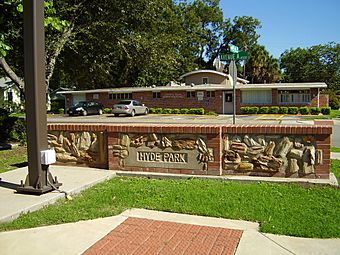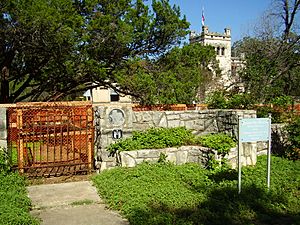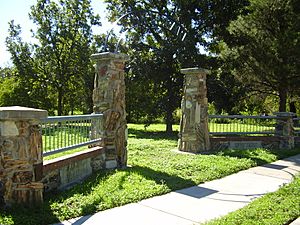Hyde Park (Austin, Texas) facts for kids
Quick facts for kids |
|
|
Hyde Park Historic District
|
|
 |
|
| Location | Roughly bounded by Ave. A, 45th St., Duval St., and 40th St., Austin, Texas |
|---|---|
| Area | 138.5 acres (56.0 ha) |
| Architectural style | Tudor Revival, Bungalow/Craftsman, Queen Anne |
| MPS | Hyde Park MPS |
| NRHP reference No. | 90001191 |
| Added to NRHP | June 29, 1990 |
Hyde Park is a cool neighborhood and historic area in Austin, Texas. It's located in Central Austin, bordered by 38th Street, 45th Street, Duval Street, and Guadalupe Street. It sits just north of the University of Texas and is next to the Hancock and North Loop neighborhoods.
Hyde Park started way back in 1891. It's known as Austin's very first suburb! It was first developed by Monroe Martin Shipe. He planned it as a "white only" streetcar suburb with a big artificial lake. This was a common practice back then, but it's very different from how communities are built today. Now, Hyde Park is one of the busiest areas in Austin's city center. Part of the neighborhood was officially listed as a Historic District in 1990.
Contents
A Look Back: Hyde Park's History

For a long time in the 1800s, the area we now call Hyde Park was mostly countryside. It was about twenty blocks from Austin's original downtown. The State Fair of Texas was even held in parts of Hyde Park from 1875 until it moved to Dallas in 1884. You can still see a hint of the old horseracing track in the curved part of 39th Street today!
How Hyde Park Began
Hyde Park was created in 1891 by the Missouri, Kansas and Texas Land and Town Company. Monroe Martin Shipe was in charge of selling it. He advertised Hyde Park as a rich, mostly white suburb with large, grand homes. It was meant to be separate from the city's neighborhoods where people of different races lived together. Ads even said Hyde Park was "free from nuisances and an objectionable class of people." This shows how different things were back then.
A big reason for the suburb's success was the new electric streetcar system. After the city allowed Shipe to build it in 1890, his company built a line from Congress Avenue all the way to Hyde Park.
Early Homes and Famous Residents
In the 1890s, Hyde Park was first marketed to Austin's wealthiest people. Shipe had some success. The first houses built there were beautiful examples of late 19th-century architecture. Many, like the Oliphant-Walker House, were built in the Queen Anne style by important local citizens.
A famous sculptor named Elisabet Ney was one of the first people to buy land here. This helped show that Hyde Park was a great place for Austin's most talented people. Ney built a small castle-like studio called Formosa in northwest Hyde Park. Today, it's the Elisabet Ney Museum!
Changes Over Time
By the late 1890s and early 1900s, the way Hyde Park was advertised started to change. It was no longer just for the rich. Instead, it was promoted as a perfect place for "working men or women" to buy a lot and build a home. The main idea became affordability.
Because of this, the homes in Hyde Park became smaller and simpler. Many were modest frame houses and bungalows. Building continued steadily through the early 1900s. But Hyde Park's biggest building boom happened between 1924 and 1935. Shipe Park was officially opened in 1928.
Today, Hyde Park has mostly renovated bungalow-style homes and modern duplexes. Many are brightly colored and have unique decorations. This helps keep Austin's fun "Keep Austin Weird" slogan alive! All the street signs in Hyde Park honor its history. Many "Austinites" (people from Austin) think Hyde Park is Austin's most locally cultured neighborhood.
Historic Districts and Buildings
The Hyde Park neighborhood has two special historic districts. It also has several other individual historic buildings. These are all listed on the National Register of Historic Places.
Hyde Park Historic District
The main Hyde Park Historic District is generally located between West 40th Street (south), West 45th Street (north), Duval Street (east), and Avenue A (west). This district features homes with Victorian architecture, Tudor Revival architecture, and bungalows.
Shadow Lawn Historic District
The Shadow Lawn Historic District is in the southeast part of Hyde Park. It's roughly bordered by 38th Street, 39th Street, Avenue G, and Duval Street. This district includes several interesting historic homes from the early 1900s.
Important Historic Buildings in Hyde Park
- Blue Bonnet Court
- Elisabet Ney Museum
- Col. Monroe M. Shipe House
- Hildreth-Flanagan-Heierman House
- Frank M. and Annie G. Covert House
- Page-Gilbert House
- Smith-Marcuse-Lowry House
- Oliphant-Walker House
- Peter and Clotilde Shipe Mansbendel House
Homes and Real Estate in Hyde Park
Most of the buildings in Hyde Park are homes, especially single-family houses. About 95% of the neighborhood is made up of these homes. Most of the lots were developed between the late 1890s and 1935. The houses built during that time show the popular architectural styles of Austin back then.
Bungalows are the most common type of house. You can also find homes influenced by the Queen Anne and Tudor Revival styles.
As Austin has grown, Hyde Park has become popular again. From 2001 to 2007, the average home price went up by almost $70,000, reaching $320,000. Even after the housing market slowed down in 2008-2009, home values bounced back. By July 2013, the average home price was $350,000, and some properties sold for over $1.5 million!
Shipe Park: A Neighborhood Gem
The 1.75-acre (7,100 m2) Shipe Park is located right in Hyde Park. It's a great place for fun! Shipe Park has:
- Two unlighted basketball courts
- One multipurpose court
- Two picnic tables
- One playground
- A swimming pool (444 square yards!)
- Two lighted tennis courts
- Indoor restrooms
Education in Hyde Park
Students living in Hyde Park attend schools in the Austin Independent School District. They are usually assigned to Lee Elementary School, Kealing Middle School, and McCallum High School. The area also has private schools like Hyde Park Schools.
A private school called Sri Atmananda Memorial School used to be in Hyde Park as well.




